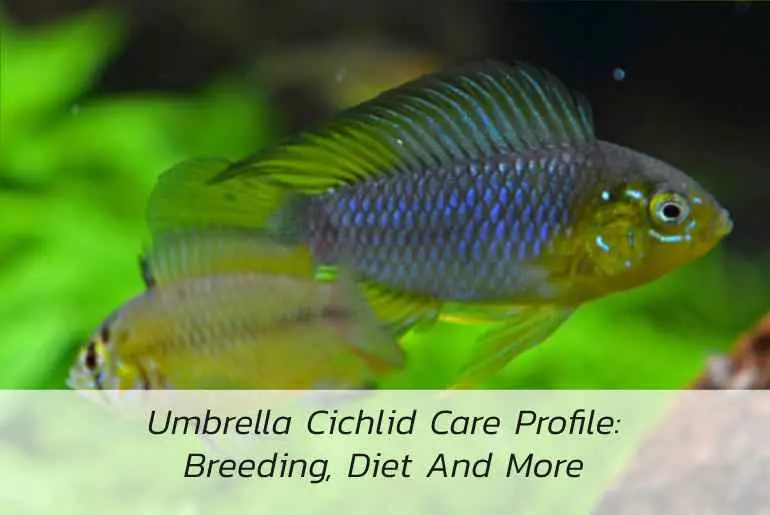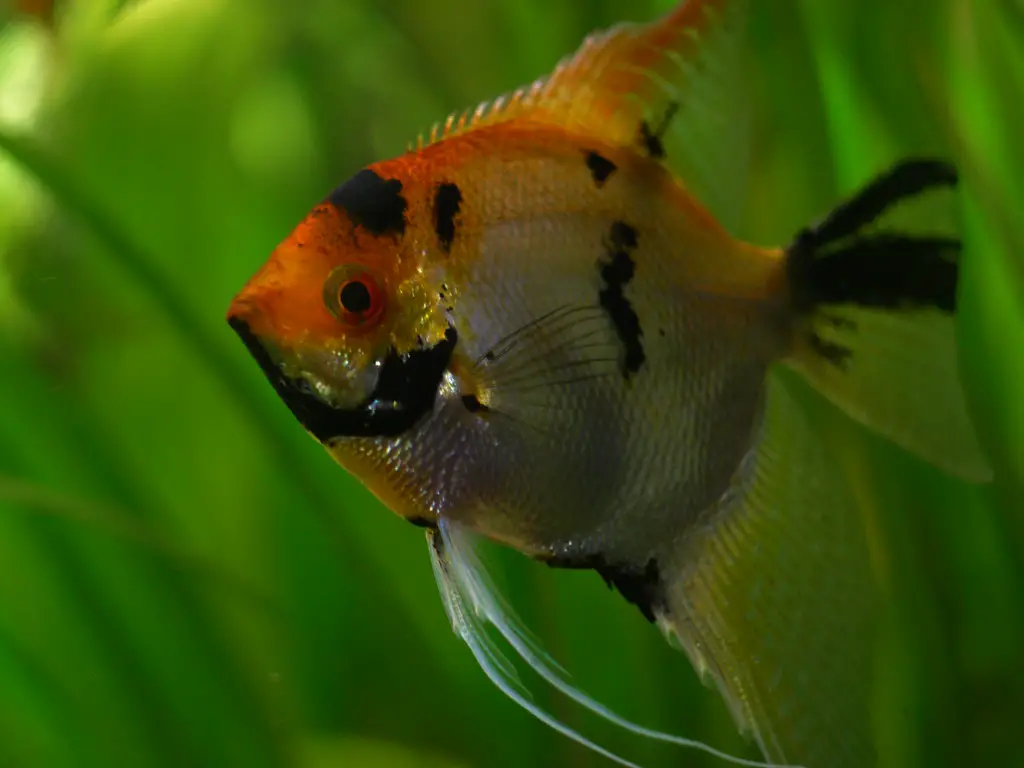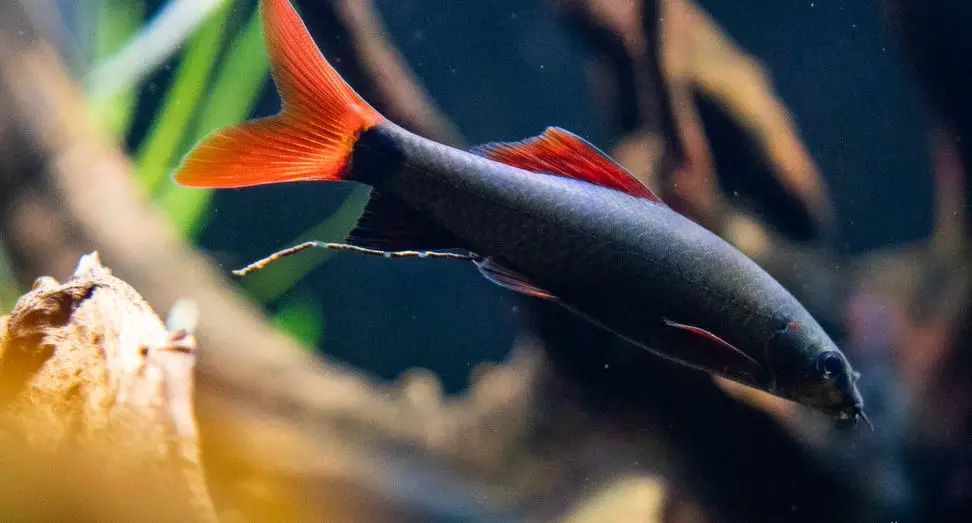How in the world do I take care of beautiful dwarf umbrella cichlids? If this is your problem, then you’ve come to the perfect place for the solution. Personally, I feel like Umbrella Cichlid is absolutely beautiful and relatively easy to take care of. So, if you’re a beginner at this, then this might be just what you’re looking for.
Umbrella Cichlids are very highly intelligent and responsive to their environment in the aquarium. They also have very curious personalities which make them curious about what happens inside as well as outside of the tank. This trait of theirs really attracts a lot of aquarists towards them.
In this article, we’ll tell you about the beautiful Umbrella Cichlid along with its personality, diet, growth factors, tank requirements, and much more!
Keep Reading to explore all the fun and interesting facts about Umbrella Cichlids.
About Umbrella Cichlid
Umbrella Cichlid, also known as Opal Umbrella Borelli Dwarf Cichlid (Apistogramma borellii “Opal”), is an extremely colorful fish commonly found in the rivers of South Africa with sandy river bottoms.
A lot of people compare them being territorial to them being aggressive, so we’re here to clear misunderstandings like such. Umbrella Cichlids are actually easy to take care of and fun to have around. Raising these fishes is very easy, but they need a special environment to be raised and bred.
Origin And Natural Habitat
Umbrella Cichlids originally come from the rivers of Mato Grosso, Pantanal, Rio das Mortes, Brazil and Paraguay. Their natural habitat is South African rivers with sandy river bottoms. Apistos are currently accepted to have a wider distribution throughout much of the Rio Paraguay, lower Rio Paraná, and Uruguay systems in southern Brazil, Paraguay, Argentina, and Uruguay.
Family
Umbrella Cichlid belongs to the family of Cichlids. Cichlids are a group of more than 1300 species of fish, a lot of them are popular aquarium fishes. They are mainly freshwater fishes that originate from tropical America, mainland Africa and Madagascar, and Southern Asia. Most cichlids are specialized feeders which allow many different types of cichlids to live together without much competition.
Order
Perciformes
Class
Ray-finned Fish
Environment
Sandy river bottoms
Appearance Of Umbrella Cichlid
The umbrella cichlid (also known as the Buenos Aires tetra) is a freshwater fish native to South America. It gets its name from its distinctive “umbrella-like” dorsal fin, which is used to ward off predators and attracted mates.
The umbrella cichlid is a popular aquarium fish due to its bright colors and playful personality. It is also a relatively easy fish to care for, making it a good choice for beginner aquarists.
Color
The umbrella cichlid is a very colorful fish with Beautiful iridescent blue-violet body coloration with very bright yellow coloration on the dorsal, anal, and caudal fins and red facial markings.
Size
Umbrella cichlids can extend to a length of about 8 centimeters. It stays relatively small as it’s a dwarf cichlid.
Female Umbrella Cichlids
Females are less colorful, but they still have an attractive appearance and plenty of personalities. Females are a bit smaller and are yellowish in color.
Male Umbrella Cichlids
Males are more colorful than females. They display opal blue bodies with red facial markings and bright yellow fins.
Understanding Umbrella Cichlids
It’s very important to understand some basic things about a fish before adopting them. So here is some info that will help you understand the Umbrella cichlids better.
Behavior/Nature And Temperament Of Umbrella Cichlids
Umbrella Cichlids are actually quiet in nature. These fish are one of the most peaceful fish species among dwarf cichlids. They swim calmly at the base of the aquarium, mostly searching for food. In fact, it is still a territorial fish that will defend its living area. But they will still remain peaceful as long as there is enough space in the aquarium. It is only a bit aggressive while breeding.
Tip: Umbrella Cichlid has a timid and fearful temper. To calm it down, you can add a lot of plants to your aquarium and add roots: it will create hiding spots and withdrawal areas highly appreciated by your fish. These fish don’t mess with the unexplored areas and are good around plants.
Compatible Tank-Mates For Umbrella Cichlids
Umbrella cichlids are peaceful cichlid species, so you don’t want to keep them with large and/or aggressive fishes. Fishes that stay smaller than three inches make the best tank mates for umbrella cichlids.
So this means that you may keep them with fish like tetras, Chinese algae eaters, Corydoras, and Plecos. You can also consider other Dwarf South African cichlids with peaceful temperaments.
Average Lifespan Of An Umbrella Cichlid
The average lifespan of Umbrella Cichlids is 5 years.
How To Take Care Of An Umbrella Cichlid?
Although Umbrella Cichlids are a strong fish, it is still important that you care for them properly. To do this, you will need to understand what they need and how to create the perfect habitat. So we are giving you all the information you need to take care of the Umbrella Cichlid perfectly!
Tank Requirements
The umbrella cichlid is a freshwater fish that originates from West Africa. It gets its name from its large dorsal fin, which resembles an umbrella. The umbrella cichlid is a peaceful species that does well in a community tank. It is also relatively easy to care for, making it a good choice for beginner aquarium enthusiasts.
Tank Size
Umbrella Cichlids are dwarf cichlids which means that they’re small. Thus, it does not require a large tank. They require an aquarium of at least 60 centimeters for a pair, but a larger tank is required for a group.
Hardness Of Tank Water
Umbrella Cichlid thrives in water with pH between 7.8 and 8.6, the general hardness between 160 and 320 parts per million, and carbonate hardness between 180 and 240 ppm.
Temperature Of Tank Water
The temperature can vary considerably in the wild. In the winter, the air temperature can drop considerably. The Umbrella Cichlids reside in shallow waters where the low air temperature causes the temperature of the water to drop to 16 and occasionally even 12 degrees Celsius. So it’s better to lessen the temperature a few degrees in winters. A bit higher temperature is needed for breeding and breeding only.
The fish is kept at the highest temperature continuously is bad for them. It results in them staying in the “breeding mode”, which can really shorten their lifespan. It is best to set the temperature to around 20 degrees.
Décor
The Umbrella Cichlid will prosper in an aquarium with a soft sandy substrate and a lot of hiding spots. Clay pots, rock formations, and driftwood would make some great hiding spots.
Cichlids love planted aquariums, but these cichlids also need a good amount of open space. The substrate should consist of soft sand that doesn’t hurt the cichlid’s abdomen because they chew on the sand looking for food particles.
Substrate
When selecting a substrate for your fish tank, choosing the one that closely resembles that found in the fish’s natural habitat is important. Soft Sandy substrate is the best for cichlids since they live on sandy river bottoms and these cichlids like to look for food in the sand.
- Carib Sea ACS05820 Super Natural Moonlight Sand for Aquarium, 5-Pound
- Carib Sea ACS05840 Super Naturals Crystal River Sand for Aquarium, 5-Pound
Plants
Decorate the aquarium with thick planting; use wood, flower pots, and half coconuts to create hiding places. Prefer tall plants with significant shade. Floating plants sifting light will also be a nice fit.
Filtration
Umbrella Cichlids are very reactive to polluted water, so make sure to refresh the water regularly. Keep your water cleanliness in check. Dirty water can cause diseases like swim bladder disease.
Lighting
The Umbrella Cichlids live in dark water in the wild. Subdued lighting works the best for them, so we advise that you set up your tank with that in mind. Remember that when the light in the tank is intense, Umbrella cichlids tend to go into hiding.
What Do Umbrella Cichlids Eat?
Umbrella Cichlids are carnivores, so there are quite a lot of food options for them. However, we advise that you customize their meals to suit what umbrella cichlids eat in the wild; lots of high-quality protein and small portions of leafy green vegetables.
Best Food Options For Umbrella Cichlids
Amazing meal options to meet their dietary needs include bloodworms, micro worms, mosquito larva, and daphnia. Frozen foods are also great options for this fish.
- Fluval A6581 Bug Bites Cichlid Pellets
- Amzey Dries Shrimp Fish Foods
- Appetizing Shrimp Mealworms
- Tetra Jumbokrill Jumbo Shrimp
- Fluval A6581 Bug Bites Cichlid Pellets
- Appetizing Shrimp Mealworms
- Tetra Jumbokrill Jumbo Shrimp
Feeding Timing
For the little ones, it’s twice per day; your fish will grow faster than once per day feeding. For grown cichlids, sometimes fasting is advised, like once per week, which helps in regulating the metabolism.
How To Breed An Umbrella Cichlid?
A little bit of a higher temperature is needed for breeding in umbrella cichlids. Fifty to Seventy eggs can be laid in a hole because originators because umbrella cichlids are cave spawners. The female chases the male away after mating, and she protects and takes good care of them. The eggs normally hatch in about four to five days. It’ll take the fries about a week to swim freely. Brine shrimp and crushed flakes can be fed to the newly hatched fry.
Common Possible Diseases In Umbrella Cichlids
Although cichlids are strong fish, these are some of the diseases that umbrella cichlids might catch-
Swim Bladder Disease
The swim bladder disease affects the part of the fish known as the swim bladder. The swim bladder is an abdominal sac that helps the fish stay afloat.
A cichlid has difficulty staying submerged when it is contacted by the swim bladder disease. There could be a lot of factors that cause this disease and one of them is external trauma because of physical injury that can potentially affect the swim bladder as well as secondary diseases like cancer and tuberculosis.
To treat this disease, we need to first find and address the initial cause of this disease, then treat it accordingly. If it’s a poor diet, we can feed our cichlids an assorted diet and offer high in fiber foods like spinach and peas to soothe constipation.
Malawi Bloat
African cichlids are the fish most seen with this disease. This disease displays in the form of symptoms such as swelling in the abdomen, loss of appetite, rapid breathing, discolored feces, and flopping at the bottom of the tank. On top of these symptoms, Malawi bloat can also cause kidney and liver damage if left untreated and neglected.
Once this disease gets to this point, it is most deadly in under three days. Performing a big water change in the tank and drenching the tank in Metronidazole is the first step to treating this disease. Remove the activated carbon from your tank filter when u change the water.
Tuberculosis
Tuberculosis is a highly contagious and, unfortunately, a common deadly aquarium fish disease. This disease can also be transmitted to humans through contact with open wounds or sores, which makes it so much scarier.
The symptoms of this disease consist of loss of appetite, frayed fins, white blotches on the skin, and a sunken stomach. The fish that are affected by this may also display behavioral changes like looking clueless or lazy.
As soon as you feel like one of your cichlids has been affected by this, shift all other fish to a hospital tank and treat the tank with melafix. Make sure you clean and disinfect the tank nicely before you move the fish back into the original tank.
Medicine
Cotton Wool Disease
Cotton wool displays itself in the form of frizzy white growings on the head, scales, and fins of contaminated cichlids. The cause of this disease is a fungus that is naturally found in the tank, which only becomes a problem if the tank is dirty.
The water quality decreases when uneaten fish food and other organic litter collect at the bottom of the tank. Antifungal medications and salt baths are the most common treatment for the cotton wool disease.
Hole In The Head Disease
Hole in the head, also known as Hexamita, is a relatively common disease in freshwater fish, but it’s mostly linked with cichlids. This disease displays itself in the form of a hole or in the head along with a loss of appetite and, therefore, weight loss. Mineral imbalance and poor water quality are suspected to be the cause of this disease.
The presence of the bacteria Hexamita is also thought to be the cause of this disease. Treating this disease is a bit challenging because the causing factor could be various things. So first, we better the water quality, then we drench the tank with an antibiotic to fight the Hexamita off.
Medicine for Hole In The Head
How To Prevent Umbrella Cichlids From Catching Diseases?
Preventing your cichlids from falling ill completely is impossible, but these are some of the things u can do.
- You can prepare yourself with knowledge or information about the conditions that can affect them the most. That’s going to help you when your fish actually gets sick. You will know the remedies, the dos, and the don’ts.
- Make sure your actions are quick because the faster the treatment, the better the results. The more your fish are left to be stressed, the sicker they get and the harder it is to treat them.
- The first thing you should do is quarantine the fish that u suspect is sick from other fishes in case it’s a contagious infection. Like this, you can observe the fish for more symptoms and provide treatment accordingly. Relax, you got this!
Frequently Asked Questions
How Aggressive Are Umbrella Cichlids?
Umbrella Cichlids are very calm and sweet little creatures. One of the most peaceful fishes.
Is Umbrella Cichlid beautiful?
Yes, Umbrella Cichlids have great appearances and are even more beautiful in nature. These fish are very colorful fish with red, yellow, and blue hues.
Are Female Umbrella Cichlids Better Than The Males?
Umbrella Cichlids are as good as the males. Females are less colorful but still have an attractive appearance and plenty of personalities. Female umbrella cichlids are a little bit smaller and are yellowish in color.
Can Umbrella Cichlids Survive Alone?
Most cichlids are able to survive alone when given food and clean water. However, it is best to adopt at least a pair or more to allow them to prosper. The only cichlid that is mostly kept alone is Oscar.
Last Words
Umbrella Cichlids is a unique cichlid with vibrant colors and a calm disposition. It favors dim-lit tanks and dark-colored substrates. With proper care, this fish will grow to its full size (2.6 inches) and live for five years.
Umbrella Cichlid is a delightful fish to raise. Its peaceful, schooling nature makes it great for beginners. Now that you know all about this fish, go ahead and use our guide to raise your fish. Let us know how it goes in the comment section.






